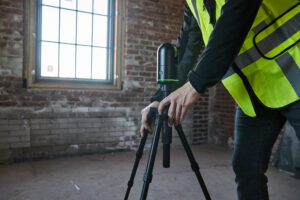
Laser scanning in construction
By Callan MacKinlay and Grace Jiyeon Shory
Construction LawAn invaluable asset in resolving construction disputes.
The increasing demand for laser scanning in construction is largely due to its extremely accurate digital record of an object or space as it pertains to a construction site. The advanced scanners use laser light to create 3-D representations known as “point clouds.” These point clouds create a database of connecting points in a 3-D-coordinate-system to create a map of the precise shape and size of physical objects. The scans, and the resulting images they create, could have useful applications in construction disputes.
Laser scanning technology can be used in various areas of a construction project. In respect to site design, laser scanning is often used contemporaneously with other design processes to validate proper design execution or aid in the overall design process. For example, implementing a 3-D laser scan of an in-progress construction site allows contractors to create a model of existing conditions, which they can use for accurate quality assurance in comparison to as-designed drawings.
Another example is a scan-to-BIM method to capture detailed information that will be used in a holistic design process to manage digital representations of physical and functional characteristics of the site.
Laser scanning should be used throughout the life of a construction project, not just during design processes. It is extremely helpful during coordination of different systems (i.e. electrical, plumbing) to avoid conflicts. Laser scanning also helps to document timelines and milestones, as it has the ability to measure and evaluate progress using a precise record of every phase of construction.
The data created by laser scanning is also useful for building operations, retrofits and renovations as it creates a permanent as-built record to be used by owners, facility managers and other key personnel. At times, it is required to create a virtual model of a site on a quick turnaround to communicate to its various stakeholders. This makes 3-D laser scanners an attractive tool since they have the ability to make the process of creating building models quick, with high accuracy compared to other processes.
Laser scanning and the accompanying point-cloud software have numerous legal applications. As mentioned, through consistent creation of laser scans during the course of a project, there will be a clear record of all progress made on the project. This will provide the contractor (or owner, as the case may be) arguing for changes to the contract valuable evidence in support.
Any disputes arising from what may or may not have been done from one scan to the next can be quickly quashed by clear and identifiable evidence of the milestones met or missed using the data collected by laser scanning. As such, laser scanning can help to mitigate against costly litigation arising out of these types of disputes during the course of the contract.
If litigation does occur, parties can use the evidence gathered using laser scanning and point-cloud software in a number of ways. Firstly, it provides counsel with a clear visualization of the scope of the project and its steps. Many projects are so large that it can be difficult for counsel on either side to assess the scope of the project, the areas worked on by their clients, and the milestones outlined in the contract. By providing counsel with VR-assisted scanning of the project, they will have a clearer picture of the entire project and can narrow the issues at hand.
Secondly, point clouds can be invaluable as factual bases for providing opinions on all manner of issues in litigation. Schedule experts can use this data to assess whether the contractual milestones were met or missed. Engineering experts are able to use point clouds to determine whether the construction of structural, electrical, HVAC, or other engineered elements were completed or coordinated according to the specifications of the contract. Other liability experts can rely on the data to determine who might be at fault for certain errors in the construction of the project.
Contractors and owners should consider the additional costs of having consistent scans taken in light of the overall size and cost of the project and the likelihood of disputes arising. For larger public projects where schedules and budgets are already fairly tight, including a provision for the usage of laser scanning and point clouds on a regular basis may very well save more money than the scans will cost.
Callan MacKinlay and Grace Jiyeon Shory are construction lawyers at Borden Ladner Gervais LLP. This article provides an overview and is not intended to be exhaustive of the subject matter contained therein. Although care has been taken to ensure accuracy, this article should not be relied upon as legal advice.







